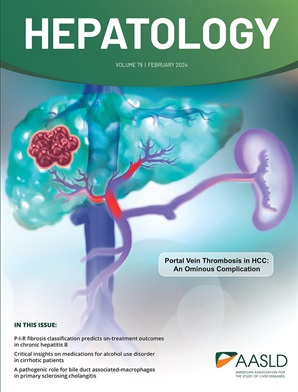IF 12.9
1区 医学
Q1 GASTROENTEROLOGY & HEPATOLOGY
引用次数: 0
摘要
背景& 目的:代谢功能障碍相关性脂肪性肝病(MASLD)给医疗保健带来了巨大负担。由于晚期肝纤维化和肝硬化对患者的预后不利,因此必须及早发现。这项多层次随机效应荟萃分析旨在为二维剪切波弹性成像(2D-SWE)检测活检证实的MASLD肝纤维化的诊断准确性提供最佳证据。方法与amp; 结果:系统检索 PubMed/MEDLINE、Embase、Scopus、Web of Science、LILACS 和 Cochrane Library 电子数据库中截至 2024 年 2 月 26 日以任何语言发表的全文文章。纳入的研究报告采用二维-SWE测量肝脏硬度(LSM),并将组织学诊断作为金标准。研究采用了线性混合效应多阈值模型,并计算了灵敏度(Se)、特异度(Sp)和曲线下面积(sAUC)的汇总估计值。20 项观察性研究(SuperSonic Imagine、通用电气医疗保健公司、佳能医疗系统公司)符合纳入标准,包括 2223 名经活检证实的 MASLD 患者。轻度纤维化(F1)、重度纤维化(F2)、晚期纤维化(F3)和肝硬化(F4)的发生率分别为 30.0%、18.5%、17.9% 和 10.9%。所有超声设备检测≥F1、≥F2、≥F3 和 F4 的 sAUCs [95%CI] 分别为 0.82 [0.16-0.98]、0.82 [0.76-0.88]、0.86 [0.77-0.93] 和 0.89 [0.80-0.95]。≥F1、≥F2、≥F3 和 F4 的最佳临界值分别为 6.432 kPa、8.174 kPa、9.418 kPa 和 11.548 kPa。结论我们的荟萃分析为病因特异性慢性肝病(MASLD)的二维-SWE纤维化分期确定了最佳的临界值,诊断效果极佳,凸显了临界值标准化的潜力。本文章由计算机程序翻译,如有差异,请以英文原文为准。
Diagnostic accuracy of 2D-SWE ultrasound for liver fibrosis assessment in MASLD: A multi-level random effects model meta-analysis
Background & Aims: Metabolic dysfunction-associated steatotic liver disease (MASLD) imposes significant healthcare burdens. Early detection of advanced fibrosis and cirrhosis in MASLD is essential due to their unfavourable outcomes. This multi-level random-effects meta-analysis aimed to provide the best evidence for the diagnostic accuracy of two-dimensional shear wave elastography (2D-SWE) in detecting liver fibrosis in biopsy-proven MASLD. Approach & Results: Systematic search in PubMed/MEDLINE, Embase, Scopus, Web of Science, LILACS, and Cochrane Library electronic databases for full-text articles published in any language up to the 26th of February 2024. Included studies reported liver stiffness measurement (LSM) by 2D-SWE and used histological diagnosis as gold standard. A linear mixed-effects multiple thresholds model was employed, and summary estimates for sensitivity (Se), specificity (Sp), and summary area under the curve (sAUC) were computed. 20 observational studies (SuperSonic Imagine, General Electric Healthcare, Canon Medical Systems) fulfilled the inclusion criteria, comprising 2223 participants with biopsy-proven MASLD. The prevalence of mild fibrosis (F1), significant fibrosis (F2), advanced fibrosis (F3), and cirrhosis (F4) was 30.0%, 18.5%, 17.9%, and 10.9%, respectively. The sAUCs [95%CI] in detecting ≥F1, ≥F2, ≥F3, and F4 for all ultrasound machines considered together were 0.82 [0.16-0.98], 0.82 [0.76-0.88], 0.86 [0.77-0.93], and 0.89 [0.80-0.95], respectively. The optimal cut-off values were 6.432 kPa for ≥F1, 8.174 kPa for ≥F2, 9.418 kPa for ≥F3, and 11.548 kPa for F4, respectively. Conclusions: Our meta-analysis identified optimised cut-offs for fibrosis staging by 2D-SWE in etiology-specific chronic liver diseases (MASLD), with excellent diagnostic performance, underscoring the potential for standardising cut-off values.
求助全文
通过发布文献求助,成功后即可免费获取论文全文。
去求助
来源期刊

Hepatology
医学-胃肠肝病学
CiteScore
27.50
自引率
3.70%
发文量
609
审稿时长
1 months
期刊介绍:
HEPATOLOGY is recognized as the leading publication in the field of liver disease. It features original, peer-reviewed articles covering various aspects of liver structure, function, and disease. The journal's distinguished Editorial Board carefully selects the best articles each month, focusing on topics including immunology, chronic hepatitis, viral hepatitis, cirrhosis, genetic and metabolic liver diseases, liver cancer, and drug metabolism.
 求助内容:
求助内容: 应助结果提醒方式:
应助结果提醒方式:


